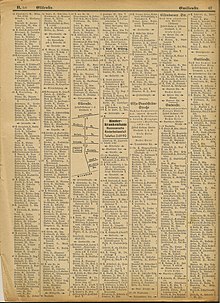Martin Gotta the Elder
Martin Gotta the Elder Ä. (born 1880 ; died 1935 or 1936 in Hanover ) was a German art and church painter and restorer .
Life
Martin Gotta possibly trained as a painter from the end of the 19th century. He was later referred to - in his son's apprenticeship letter - as a “church painter of the painting and varnishing trade”.
In 1901, Martin Gotta enrolled at the Technical University of Hanover - without specifying subjects . Soon afterwards he worked in Berlin as an employee of the imperial court painter August Oetken in Berlin.

1909 Gotta was not in the address book, city and business Manual of the Royal Capital and Residence of Hannover ... recorded. He did not found his own church painting business in the city until 1911, was listed for the first time in 1912 as the only head of household with this name in Hanover and in 1913 as a painter who lived at 4 Emilienstrasse . During this period, on June 12, 1912, Gottas Martin's son Hans Karl Martin Gotta was born; the family's address remained on Emilienstraße, which was later renamed Wildermuthweg.
During the First World War Gotta worked as a military service .
Martin Gotta described himself in his early creative period as a “painter for ecclesiastical and profane painting”, in later years as a “church painter - restorer of ecclesiastical art monuments”. In fact, he mainly received orders for sacred interiors, both on the walls and on the furnishings. The clients were mostly Protestant parishes , mainly in the area of the Evangelical Lutheran Church of Hanover , and - with the exception of his activities in Lemgo - almost exclusively in the area of today's Lower Saxony.
From 1929 to 1933 Gotta trained his son as a painter and varnisher in his own company. From 1933 father and son worked together in the company until Gotta's death in 1936, which was then continued by Martin Gotta the Younger.
The obituary notice for Martin Gotta in the Hannoversche Kurier of January 7, 1936 contained no life data.
Works (selection)
- In 1921 Gotta provided the walls and vaults of the St. Vitus Church in Wilkenburg with a neo-baroque painting that shaped the interior of the sacred building up to 1952. During his work he also exposed older wall paintings. In addition to other color work, the altar and the organ were cleaned and their paintwork revised.
- "AD 1922" dates the artist's signature "Martin Gotta Hanover Church Painter" on the wooden pulpit, which is framed by this color, from 1600 in the church of St. Nicolai in Lemgo. He painted the church there from 1920 to 1921.
- 1923–1926: Restoration of the vault and wall paintings in Leveste near Gehrden
- 1927: Restoration of the paintings in the nuns choir of the Wienhausen monastery
- 1927: Restoration of the painting of the choir in the church of Großenwieden near Hessisch-Oldendorf
- 1927: Restoration of the vault paintings in the south aisle of the church in Hattendorf near Auetalc
- 1928: Restoration of the paintings and the setting of the altarpiece of the Protestant church in Undeloh
- 1934: Restoration work inside the Melle church
In 1934, Gotta and his son restored the collection of paintings in the Clausthal-Zellerfeld district office .
By the end of 1936 Martin Gotta had designed the churches in Barum , Coasts and Meuchefitz near Lüchow and - again together with his son - before 1936:
- Painting of the church in Belge
- 1930s: Repair of paintings and repair of the carved altar in the church of Groß Liedern
- Painting of the church in Hagen
- Painting of the church in Kirchweyhe
- Painting of the church in Natendorf
- Painting of the Martinskirche in Nienburg / Weser
- Painting of the church in Nettelkamp
- Painting of the church in Steimbke
- Painting of the church of St. Marien in Veerßen near Uelzen
Archival material
Archival materials from and about Martin Gotta can be found, for example
- in the Rosche parish archive, archive signature Best.Ro.No. 511
Individual evidence
- ↑ a b c d e f g h i j k l m n o p q r s t u v w x y Stefanie Lindemeier: The performing arts and church painters , as well as short biographies Gotta, Hans Karl Martin and Gotta, Martin , in dies .: Studies on the restoration history of medieval vaults and wall paintings in the area of today's Lower Saxony: Representation of historical methods, technology and materials , dissertation 2009 at the Dresden University of Fine Arts, Volume 2 (text volume), p. 53 ff. 309, v. a. P. 310; Digitized version of the Dresden University of Fine Arts
- ↑ Address Book, city and business Manual of the Royal Capital and Residence of the city Hannover Linden and the village Ricklingen and the colony Leinhausen 1912 , Division III: Alphabetical List of residents and traders , p 161 ; as well as in the address book for 1913, ibid. p. 161 as digital copies of the Gottfried Wilhelm Leibniz Library - Lower Saxony State Library via the German Research Foundation
- ↑ a b c Bernd Adam, Michael A. Flechtner: The St. Vitus Church in Wilkenburg - Nine centuries of planning and building history . Celle. Ströher-Druck 2001, p. 57 and notes 193, 194 on p. 77
- ^ Sabine Wehking : DI 59, No. 136 on the page Deutsche Insschriften Online (DIO)
| personal data | |
|---|---|
| SURNAME | Gotta, Martin the Elder |
| ALTERNATIVE NAMES | Gotta, Martin the Elder Ä. |
| BRIEF DESCRIPTION | German painter and church painter as well as restorer |
| DATE OF BIRTH | 1880 |
| DATE OF DEATH | 1935 or 1936 |
| Place of death | Hanover |